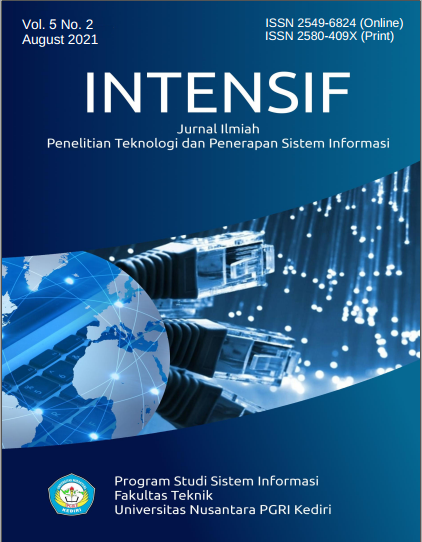The Natural Disaster Prone Index Map Model in Indonesia Using the Thiessen Polygon Method
DOI:
https://doi.org/10.29407/intensif.v5i2.14612Keywords:
Polygon Thiessen, Indonesia, Natural Disaster, Mapping, System Information GeographicAbstract
Natural Disasters are natural phenomena that occur at any moment that can cause loss. Indonesia is an archipelagic country located at the meeting of four tectonic plates and volcanic belts. This condition causes Indonesia to be prone to natural disasters. Therefore, it is necessary to make a natural disaster-prone index map model minimize the impact of natural disasters. In this research, the researchers used a Polygon Thiessen method for it was one of the mapping methods to determine a natural disaster based on Indonesia's vast surface and many disasters. The BNPB and Polygon Thiessen data comparison shows that BNPB data has a low level of vulnerability of 302, a moderate level of vulnerability of 148, and a high level of vulnerability of 58. In contrast, the Thiessen polygon has a low level of vulnerability of 297, a moderate vulnerability of 158, and a high vulnerability of 59. Comparing BNPB data and the Thiessen Polygon method found five differences from 40 data in the Papua region. Suggestions for further research to create an application-based information system so that it can be accessed in real-time.
Downloads
References
J. A. Nugroho, B. M. Sukojo, and I. Sari, “Pemetaan Daerah Rawan Longsor dengan Penginderaan Jauh dan Sistem Informasi Geografis,” ITS Libr., p. 9, 2009.
M. Restu; Damanik; Ridha S, “PEMETAAN TINGKAT RISIKO BANJIR DAN LONGSOR SUMATERA UTARA BERBASIS SISTEM INFORMASI GEOGRAFIS,” pp. 29–42, 2544.
“Data Informasi Bencana Indonesia (DIBI).” [Online]. Available: http://bnpb.cloud/dibi//tabel1a. [Accessed: 14-Apr-2020].
“Potensi Ancaman Bencana - BNPB.” [Online]. Available: https://bnpb.go.id/potensi-ancaman-bencana. [Accessed: 08-May-2020].
N. Novitasari, A. Nugraha, and A. Suprayogi, “Pemetaan Multi Hazards Berbasis Sistem Informasi Geografis Di Kabupaten Demak Jawa Tengah,” J. Geod. Undip, vol. 4, no. 4, pp. 181–190, 2015.
B. Gunadi, A. Nugraha, and A. Suprayogi, “Aplikasi Pemetaan Multi Risiko Bencana Di Kabupaten Banyumas Menggunakan Open Source Software Gis,” J. Geod. Undip, vol. 4, no. 4, pp. 287–296, 2015.
M. Farizki and W. Anurogo, “Pemetaan kualitas permukiman dengan menggunakan penginderaan jauh dan SIG di kecamatan Batam kota, Batam,” Maj. Geogr. Indones., vol. 31, no. 1, p. 39, 2017.
R. Rahmad, S. Suib, and A. Nurman, “Aplikasi SIG Untuk Pemetaan Tingkat Ancaman Longsor Di Kecamatan Sibolangit, Kabupaten Deli Serdang, Sumatera Utara,” Maj. Geogr. Indones., vol. 32, no. 1, p. 1, 2018.
M. Infromasi, P. Ilmu, P. Kegeografian, L. Di, and K. Kejajar, “Pemanfaatan Teknologi Sig Untuk Pemetaan Tingkat Ancaman Longsor Di Kecamatan Kejajar, Wonosobo,” Pemanfaat. Teknol. Sig Untuk Pemetaan Tingkat Ancaman Longsor Di Kec. Kejajar, Wonosobo, vol. 12, no. 2, pp. 202–213, 2015.
F. Faizana, A. Nugraha, and B. Yuwono, “Pemetaan Risiko Bencana Tanah Longsor Kota Semarang,” J. Geod. Undip, vol. 4, no. 1, pp. 223–234, 2015.
R. Pratiwi, A. Nugraha, and H. ah, “Pemetaan Multi Bencana Kota Semarang,” J. Geod. Undip, vol. 5, no. 4, pp. 122–131, 2016.
E. W. Weisstein, “Voronoi Diagram.”
B. Triatmodjo, “Hidrologi Terapan,” Beta Offset, 2008.
“GADM maps.” [Online]. Available: https://gadm.org/maps.html. [Accessed: 14-Aug-2020].
K. Lilik, R. Yunus, robi amir Muhammd, and P. Narwawi, “Indek Ks Rawa an Benc Cana in Ndones,” pp. 1–226, 2011.
K. D. Hartomo, J. P. Sri Yulianto, and E. Gumilanggeng, “Spatial model of koppen climate classification using thiessen polygon optimization algorithm,” J. Theor. Appl. Inf. Technol., vol. 96, no. 2, pp. 382–391, 2018.
S. Y. J. Prasetyo, “Model Prediksi Hujan dengan Kombinasi Metode Double Exponential Smooth, Thiessen Polygon, dan Isohyetal Wilayah Stasiun Iklim Jawa Tengah,” pp. 2–18, 2011.
Downloads
Published
Issue
Section
License
Authors who publish with this journal agree to the following terms:
- Copyright on any article is retained by the author(s).
- The author grants the journal, the right of first publication with the work simultaneously licensed under a Creative Commons Attribution License that allows others to share the work with an acknowledgment of the work’s authorship and initial publication in this journal.
- Authors are able to enter into separate, additional contractual arrangements for the non-exclusive distribution of the journal’s published version of the work (e.g., post it to an institutional repository or publish it in a book), with an acknowledgment of its initial publication in this journal.
- Authors are permitted and encouraged to post their work online (e.g., in institutional repositories or on their website) prior to and during the submission process, as it can lead to productive exchanges, as well as earlier and greater citation of published work.
- The article and any associated published material is distributed under the Creative Commons Attribution-ShareAlike 4.0 International License













